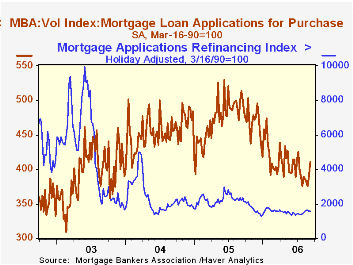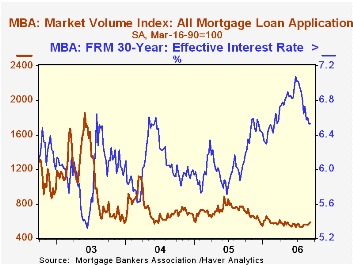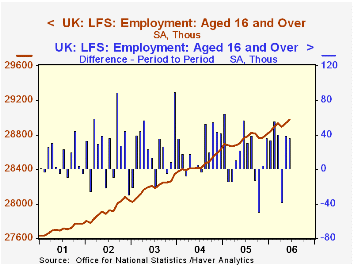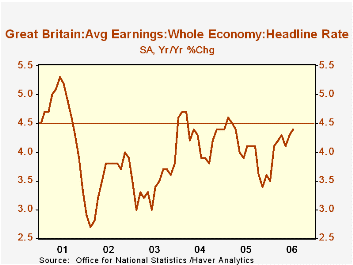 Global| Sep 13 2006
Global| Sep 13 2006Mortgage Applications For Home Purchase Up
by:Tom Moeller
|in:Economy in Brief
Summary
For the second consecutive week, a firm rise in the number of mortgage applications for purchase led overall mortgage apps higher, according to the Mortgage Bankers Association. Purchase applications added 5.3% to the prior week's [...]

For the second consecutive week, a firm rise in the number of mortgage applications for purchase led overall mortgage apps higher, according to the Mortgage Bankers Association. Purchase applications added 5.3% to the prior week's 3.7% rise and lifted applications in September 4.4% above the August average which fell 3.5% from July.
During the last ten years there has been a 58% correlation between the y/y change in purchase applications and the change in new plus existing single family home sales.
Overall mortgage applications rose 3.2% last week after the prior period's 1.8% increase.
Applications to refinance ticked up 0.1% following the prior week's 0.9% decline. The average level of refis in September is up 1.0% from August which surged 13.3% m/m from July.
The effective interest rate on a conventional 30-year mortgage was stable w/w at 6.53%. The peak for 30 year financing was 7.08% late in June. The rate on 15-year financing also was stable w/w at 6.25% and the peak rate was 6.75%. Interest rates on 15 and 30 year mortgages are closely correlated (>90%) with the rate on 10 year Treasury securities.
During the last ten years there has been a (negative) 79% correlation between the level of applications for purchase and the effective interest rate on a 30-year mortgage.
The Mortgage Bankers Association surveys between 20 to 35 of the top lenders in the U.S. housing industry to derive its refinance, purchase and market indexes. The weekly survey accounts for more than 40% of all applications processed each week by mortgage lenders. Visit the Mortgage Bankers Association site here.
Can Housing Be Green and Affordable? from the Federal Reserve Bank of Atlanta can be found here.
| MBA Mortgage Applications (3/16/90=100) | 09/08/06 | 09/01/06 | Y/Y | 2005 | 2004 | 2003 |
|---|---|---|---|---|---|---|
| Total Market Index | 584.2 | 566.3 | -23.2% | 708.6 | 735.1 | 1,067.9 |
| Purchase | 410.2 | 389.7 | -20.1% | 470.9 | 454.5 | 395.1 |
| Refinancing | 1,597.0 | 1,594.7 | -27.4% | 2,092.3 | 2,366.8 | 4,981.8 |
by Carol Stone September 13, 2006

Prime Minister Blair gave away a key piece of UK labor market data Tuesday at a speech to the Trades Union Congress, letting people know that the so-called "claimant count" would see a "welcome" fall. Indeed, as the ONS reported officially this morning, the number of people claiming the Jobseeker's Allowance eased to 950,100 in August from 954,000 in July and 955,000 in June. These compare to 869,300 in August 2005 and a monthly average of 861,000 for all of last year. While the monthly figure did decline then, the most that can really be said about the data is that it didn't worsen.
The UK's broader unemployment rate, following the widely used ILO definition, also indicated stabilization, but not improvement. It remained at 5.5% in the June reporting period, the three months centered on June, the same as in the May period. These compare with 4.7% a year ago. The number of people employed rose in the June period by 37,000 following a 39,000 gain in May. April's reading was down 38,000, so the three periods together leave employment in a very gentle uptrend, 0.8% higher than a year ago.
Markets focused on the lower claimant count, and they also noticed the rise in wages. The July reading on the average earnings index picked up to a 4.4% advance over a year ago, after June's 4.3% and May's 4.1%. Even so, the latest figure remains just below the Bank of England's threshold for inflation concern that sets in at 4.5%, suggesting that any monetary policy change won't come immediately, though some see a rate hike late this year. [The "AEI" is the index of average hourly earnings over the last three months relative to the same period a year ago. While the employment reading is generally taken on the middle month of a three-month moving average, the AEI highlights the ending month. So this is the "July" AEI, and the "June" employment and unemployment data, but they actually cover the same period: May, June and July.]
| UK Labor Force Survey & Related Labor Data | Aug 2006 | July 2006 | June 2006 | May 2006 | Year Ago | 2005 | 2004 | 2003 |
|---|---|---|---|---|---|---|---|---|
| Employment (3Mo Avg, SA, Thous) |
-- | -- | 28,975 | 28,938 | 28,755 | 28,743 | 28,465 | 28,183 |
| Chg from 1 & 3 Months Ago | -- | -- | 37/38 | 39/42 | +18 (MoAvg) | 1.0% | 1.0% | 1.0% |
| Unemployment Rate (3Mo Avg, SA, %) |
-- | -- | 5.5% | 5.5% | 4.7% | 4.8% | 4.8% | 5.0% |
| Claimant Count (Monthly, Thous) |
950.1 | 954.0 | 955.0 | 950.7 | 869.3 | 861.8 | 853.5 | 933.1 |
| Vacancies (Monthly, Thous) | 600.4 | 617.0 | 604.2 | 584.2 | 609.6 | 619.0 | 631.9 | 582.0 |
| Average Earnings Index inc Bonus (Headline Rate*) | -- | 4.4% | 4.3% | 4.1% | 4.3% | 4.1% | 4.3% | 3.4% |
Tom Moeller
AuthorMore in Author Profile »Prior to joining Haver Analytics in 2000, Mr. Moeller worked as the Economist at Chancellor Capital Management from 1985 to 1999. There, he developed comprehensive economic forecasts and interpreted economic data for equity and fixed income portfolio managers. Also at Chancellor, Mr. Moeller worked as an equity analyst and was responsible for researching and rating companies in the economically sensitive automobile and housing industries for investment in Chancellor’s equity portfolio. Prior to joining Chancellor, Mr. Moeller was an Economist at Citibank from 1979 to 1984. He also analyzed pricing behavior in the metals industry for the Council on Wage and Price Stability in Washington, D.C. In 1999, Mr. Moeller received the award for most accurate forecast from the Forecasters' Club of New York. From 1990 to 1992 he was President of the New York Association for Business Economists. Mr. Moeller earned an M.B.A. in Finance from Fordham University, where he graduated in 1987. He holds a Bachelor of Arts in Economics from George Washington University.






